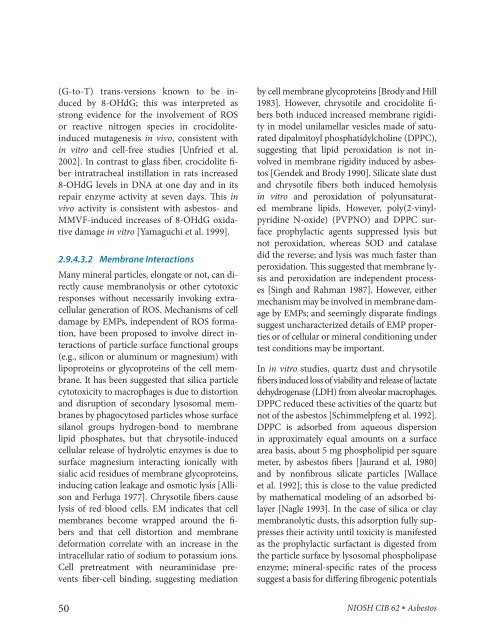Asbestos Fibers and Other Elongate Mineral Particles: State of the ...
Asbestos Fibers and Other Elongate Mineral Particles: State of the ...
Asbestos Fibers and Other Elongate Mineral Particles: State of the ...
- No tags were found...
Create successful ePaper yourself
Turn your PDF publications into a flip-book with our unique Google optimized e-Paper software.
(G-to-T) trans-versions known to be induced<br />
by 8-OHdG; this was interpreted as<br />
strong evidence for <strong>the</strong> involvement <strong>of</strong> ROS<br />
or reactive nitrogen species in crocidolite-<br />
induced mutagenesis in vivo, consistent with<br />
in vitro <strong>and</strong> cell-free studies [Unfried et al.<br />
2002]. In contrast to glass fiber, crocidolite fiber<br />
intratracheal instillation in rats increased<br />
8-OHdG levels in DNA at one day <strong>and</strong> in its<br />
repair enzyme activity at seven days. This in<br />
vivo activity is consistent with asbestos- <strong>and</strong><br />
MMVF-induced increases <strong>of</strong> 8-OHdG oxidative<br />
damage in vitro [Yamaguchi et al. 1999].<br />
2.9.4.3.2 Membrane Interactions<br />
Many mineral particles, elongate or not, can directly<br />
cause membranolysis or o<strong>the</strong>r cytotoxic<br />
responses without necessarily invoking extracellular<br />
generation <strong>of</strong> ROS. Mechanisms <strong>of</strong> cell<br />
damage by EMPs, independent <strong>of</strong> ROS formation,<br />
have been proposed to involve direct interactions<br />
<strong>of</strong> particle surface functional groups<br />
(e.g., silicon or aluminum or magnesium) with<br />
lipoproteins or glycoproteins <strong>of</strong> <strong>the</strong> cell membrane.<br />
It has been suggested that silica particle<br />
cytotoxicity to macrophages is due to distortion<br />
<strong>and</strong> disruption <strong>of</strong> secondary lysosomal membranes<br />
by phagocytosed particles whose surface<br />
silanol groups hydrogen-bond to membrane<br />
lipid phosphates, but that chrysotile-induced<br />
cellular release <strong>of</strong> hydrolytic enzymes is due to<br />
surface magnesium interacting ionically with<br />
sialic acid residues <strong>of</strong> membrane glycoproteins,<br />
inducing cation leakage <strong>and</strong> osmotic lysis [Allison<br />
<strong>and</strong> Ferluga 1977]. Chrysotile fibers cause<br />
lysis <strong>of</strong> red blood cells. EM indicates that cell<br />
membranes become wrapped around <strong>the</strong> fibers<br />
<strong>and</strong> that cell distortion <strong>and</strong> membrane<br />
deformation correlate with an increase in <strong>the</strong><br />
intracellular ratio <strong>of</strong> sodium to potassium ions.<br />
Cell pretreatment with neuraminidase prevents<br />
fiber-cell binding, suggesting mediation<br />
50<br />
by cell membrane glycoproteins [Brody <strong>and</strong> Hill<br />
1983]. However, chrysotile <strong>and</strong> crocidolite fibers<br />
both induced increased membrane rigidity<br />
in model unilamellar vesicles made <strong>of</strong> saturated<br />
dipalmitoyl phosphatidylcholine (DPPC),<br />
suggesting that lipid peroxidation is not involved<br />
in membrane rigidity induced by asbestos<br />
[Gendek <strong>and</strong> Brody 1990]. Silicate slate dust<br />
<strong>and</strong> chrysotile fibers both induced hemolysis<br />
in vitro <strong>and</strong> peroxidation <strong>of</strong> polyunsaturated<br />
membrane lipids. However, poly(2-vinylpyridine<br />
N-oxide) (PVPNO) <strong>and</strong> DPPC surface<br />
prophylactic agents suppressed lysis but<br />
not peroxidation, whereas SOD <strong>and</strong> catalase<br />
did <strong>the</strong> reverse; <strong>and</strong> lysis was much faster than<br />
peroxidation. This suggested that membrane lysis<br />
<strong>and</strong> peroxidation are independent processes<br />
[Singh <strong>and</strong> Rahman 1987]. However, ei<strong>the</strong>r<br />
mechanism may be involved in membrane damage<br />
by EMPs; <strong>and</strong> seemingly disparate findings<br />
suggest uncharacterized details <strong>of</strong> EMP properties<br />
or <strong>of</strong> cellular or mineral conditioning under<br />
test conditions may be important.<br />
In in vitro studies, quartz dust <strong>and</strong> chrysotile<br />
fibers induced loss <strong>of</strong> viability <strong>and</strong> release <strong>of</strong> lactate<br />
dehydrogenase (LDH) from alveolar macrophages.<br />
DPPC reduced <strong>the</strong>se activities <strong>of</strong> <strong>the</strong> quartz but<br />
not <strong>of</strong> <strong>the</strong> asbestos [Schimmelpfeng et al. 1992].<br />
DPPC is adsorbed from aqueous dispersion<br />
in approximately equal amounts on a surface<br />
area basis, about 5 mg phospholipid per square<br />
meter, by asbestos fibers [Jaur<strong>and</strong> et al. 1980]<br />
<strong>and</strong> by nonfibrous silicate particles [Wallace<br />
et al. 1992]; this is close to <strong>the</strong> value predicted<br />
by ma<strong>the</strong>matical modeling <strong>of</strong> an adsorbed bilayer<br />
[Nagle 1993]. In <strong>the</strong> case <strong>of</strong> silica or clay<br />
membranolytic dusts, this adsorption fully suppresses<br />
<strong>the</strong>ir activity until toxicity is manifested<br />
as <strong>the</strong> prophylactic surfactant is digested from<br />
<strong>the</strong> particle surface by lysosomal phospholipase<br />
enzyme; mineral-specific rates <strong>of</strong> <strong>the</strong> process<br />
suggest a basis for differing fibrogenic potentials<br />
NIOSH CIB 62 • <strong>Asbestos</strong>

















